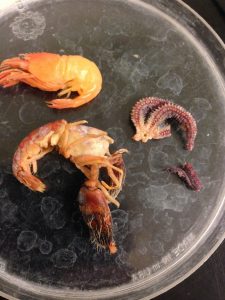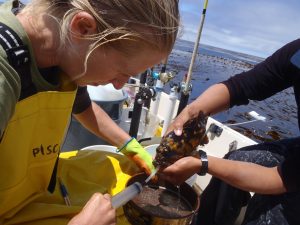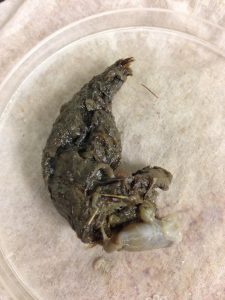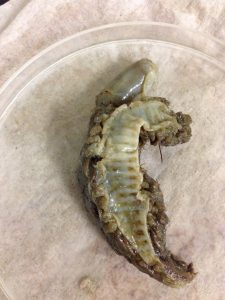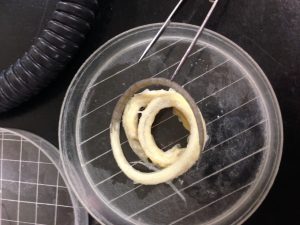 My last research update post was late last summer when I was still in the field, enjoying time on the sea – diving, fishing and boating. But, the fun inevitably ended and I’m left with piles of samples to process. Frozen fish heads filling lab freezers, vials of rockfish prey items soaking in ethanol, dried fin clips in envelopes covering my desk, fish ear bones (otoliths) drying in glass jars.
My last research update post was late last summer when I was still in the field, enjoying time on the sea – diving, fishing and boating. But, the fun inevitably ended and I’m left with piles of samples to process. Frozen fish heads filling lab freezers, vials of rockfish prey items soaking in ethanol, dried fin clips in envelopes covering my desk, fish ear bones (otoliths) drying in glass jars.The most exiting of these samples are the stomach contents – the fish puke preserved in ethanol and stored in a freezer. Aside from being fun to look at (and they are!), a look at a fish’s last meal can tell us a lot. Because I’m interested in the factors that contribute to production variability in nearshore fish populations, changes in a species’ diet is very important. I’m currently quantifying the extent and magnitude of predation by adult rockfish (and cabbies and lings) on juvenile rockfish YOY (young-of-the-year). By looking at predation patterns over time, then analyzing this data in the context of annual growth information (that I’ll be getting from otoliths – more about that in another post), I’ll be able to determine the influence that variation in YOY has on adult rockfish production.
My undergraduate work was done at Valparaiso University – thousands of miles from the nearest ocean. Not surprisingly, Valpo did not offer a Marine Invert Zoology course, so I did not come into this endeavor with much invertebrate identification knowledge at all. It’s been a learning process that I took on with a wonderful undergraduate volunteer from UCSC’s ecology program. I’ve learned that on long days – past the time in the afternoon when I want to stare at a computer, staring instead into a dissecting scope at partially-digested marine organisms makes for a very productive end to the day. Take a look below for a sampling of the prey items I’ve found.
A full red octopus (Octopus rubescens) is hard to mistake for anything else, though when only a tentacle or beak is present it can be tough to tell an octopus from a squid, both Cephalopods.
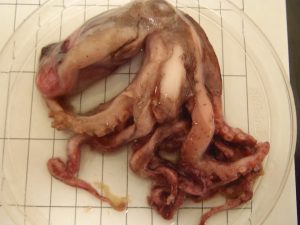
Crabs were found in many rockfish and cabezon stomachs. Below is a cryptic kelp crab (Pugettia richii), commonly found in Monterey Bay.

In the next photo you can clearly pick out two critters of the order Decapoda. The top shrimp is a Caridean (Infraoder: Caridea) and the bottom is a pistol shrimp (also a Caridean but of Family: Alpheidae). Another very common Crustacean that we find are gammarid amphipods (Family: Gammaridae). Note: to the left of the shrimp, you see part of a brittle star (Class: Ophiuroidea) which is not a Crustacean at all, but an Echinoderm! This all came from the stomach of a black-and-yellow rockfish (Sebastes chrysomelas).
stomach.
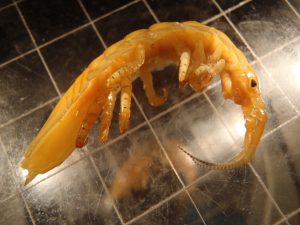
Sometimes you empty a vial and it looks really nice and un-intimidating like this. The larger fish pictured here is a Sebastes YOY!
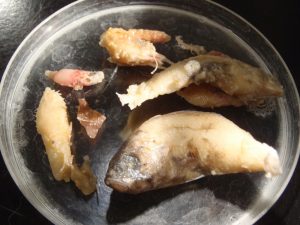
Other times you empty a vial and have piles of mostly-digested mush, an assortment of claws (none of which seem to go together), white clumps that could be fish flesh, and arthropod bits.
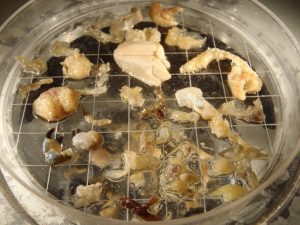
Wonder how we got adult rockfish – the unhappy, spiny mothers that they are – to give up their hard-fought for meals? Most of the fish sampled were caught on hook-and-line, then went through a quick stomach-flushing procedure that scientists like to call gastric lavage. For fish that size that I work with, an 100-mL syringe filled with seawater and a sieve works nicely.
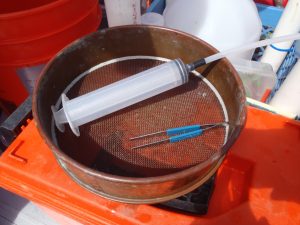
It’s a sea mouse (Genus: Aphroditidae)! A large gopher rockfish (Sebastes carnatus) yielded this polychaete worm – a creature I didn’t even know existed.
